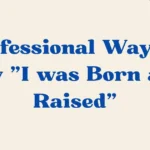When it comes to writing whether in essays, reports, or personal letters the words we choose shape how our message is received. A phrase like “at your convenience” is polite, but it can sometimes feel formal or distant.
By exploring warmer and more nuanced alternatives such as “whenever you’re ready,” “at your leisure,” “when it suits you,” “as you see fit,” or “on your schedule,” you can make your communication more engaging and thoughtful.
In this guide, we’ll uncover 33 creative alternatives from “when you get a chance” to “at your own pace” or “when you feel like it.”
What Does “At Your Convenience” Mean in Professional Communication?
The phrase “at your convenience” is a polite way to signal flexibility, showing that the recipient can respond, act, or schedule something when it works best for them. It conveys respect for their time while keeping the message professional.
When Is It Appropriate to Use the Phrase “At Your Convenience”?
This expression works well in emails, meeting requests, or follow-ups where you want to avoid pressure, such as asking for feedback, scheduling a call, or requesting documents. It helps maintain professionalism while keeping the tone courteous.
Are There Better Alternatives to Saying “At Your Convenience”?
Yes, options like “whenever you’re ready,” “at your leisure,” “when it suits you,” or “on your schedule” can sound more warm and personal while still professional. Choosing the right alternative depends on the relationship, tone, and level of formality you want to convey.
1. Whenever You’re Ready
Meaning: Implies patience and openness, giving the other person control over timing.
Definition: A phrase that allows flexibility without urgency.
Tone: Supportive and considerate.
Example: “Feel free to send me the draft whenever you’re ready.”
Explanation: This phrase helps reduce pressure and encourages a more natural response.
Purpose and Personalization: Use it to foster trust and comfort; personalize by adding context such as “whenever you’re ready, I’d love to review it together.”
2. At Your Leisure
Meaning: Suggests a relaxed, pressure-free approach.
Definition: A phrase that conveys no strict deadline, only preference.
Tone: Polite and easygoing.
Example: “Please review the attached notes at your leisure.”
Explanation: It reassures the reader that they can act when convenient.
Purpose and Personalization: Best for formal communication; adjust tone by softening with warmth like “at your leisure, no rush at all.”
3. When It Suits You
Meaning: Highlights the recipient’s preference as the priority.
Definition: A phrase used to show adaptability to another’s schedule.
Tone: Respectful and flexible.
Example: “Let’s arrange a meeting when it suits you.”
Explanation: It places control in the reader’s hands, encouraging collaboration.
Purpose and Personalization: Ideal for professional settings; make it personal by tying it to a specific context, such as “when it suits you this week.”
4. At Your Own Pace
Meaning: Encourages working or responding without time pressure.
Definition: A phrase emphasizing autonomy and comfort.
Tone: Gentle and encouraging.
Example: “You can complete the form at your own pace.”
Explanation: It removes stress, making tasks feel manageable.
Purpose and Personalization: Great for supportive communication; personalize by recognizing effort: “at your own pace—you’re doing great.”
5. As You See Fit

Meaning: Signals trust in the reader’s judgment.
Definition: A phrase granting discretion and authority.
Tone: Respectful and empowering.
Example: “Please edit the draft as you see fit.”
Explanation: It values the recipient’s expertise and choices.
Purpose and Personalization: Works well in collaborative contexts; adjust by adding appreciation: “as you see fit, since your perspective is valuable.”
6. Find More Words!
Meaning: Invites exploration of new vocabulary and phrasing.
Definition: A phrase that motivates creativity in communication.
Tone: Encouraging and inspiring.
Example: “Don’t stop here—find more words that fit your style.”
Explanation: It sparks curiosity and broadens expressive range.
Purpose and Personalization: Helps writers grow their voice; personalize by suggesting synonyms aligned with their audience.
7. When You Have Time
Meaning: Suggests flexibility without imposing urgency.
Definition: A polite request that respects availability.
Tone: Courteous and thoughtful.
Example: “Please call me back when you have time.”
Explanation: It avoids pressure while still requesting action.
Purpose and Personalization: Ideal for informal exchanges; soften it with empathy like “when you have time, I’d love to hear from you.”
8. At Your Discretion
Meaning: Gives the recipient authority to decide.
Definition: A phrase granting freedom of choice.
Tone: Formal and respectful.
Example: “You may share the details at your discretion.”
Explanation: It reflects trust and responsibility.
Purpose and Personalization: Best for professional communication; adjust by noting boundaries if necessary.
9. When It Works for You
Meaning: Aligns actions with the reader’s schedule.
Definition: A flexible phrase accommodating availability.
Tone: Friendly and cooperative.
Example: “Let’s catch up when it works for you.”
Explanation: It emphasizes mutual respect and convenience.
Purpose and Personalization: Great for both formal and casual writing; personalize by anchoring to context like “when it works for you this month.”
10. As You Prefer
Meaning: Emphasizes choice and personal comfort.
Definition: A phrase that allows the recipient to set preferences.
Tone: Polite and accommodating.
Example: “You can choose the format as you prefer.”
Explanation: It ensures the reader feels valued.
Purpose and Personalization: Useful in collaborative work; adjust tone by showing openness: “as you prefer, your choice matters.”
11. At Your Convenience
Meaning: Suggests action can be taken whenever it suits the other person.
Definition: A polite, flexible expression.
Tone: Professional and courteous.
Example: “Please contact me at your convenience.”
Explanation: It acknowledges the recipient’s priorities.
Purpose and Personalization: Works in business contexts; personalize by softening: “at your convenience, no pressure at all.”
Read More: Best Ways to Say “Asset to Your Company”
12. When You Feel Like It
Meaning: Offers complete freedom and flexibility.
Definition: A casual phrase emphasizing choice.
Tone: Relaxed and friendly.
Example: “Finish the task when you feel like it.”
Explanation: It reduces formality and stress.
Purpose and Personalization: Suitable for casual contexts; adjust by adding reassurance: “when you feel like it, take your time.”
13. When You Get a Chance

Meaning: Acknowledges busy schedules while requesting attention.
Definition: A polite way of asking without urgency.
Tone: Thoughtful and respectful.
Example: “Could you review the file when you get a chance?”
Explanation: It keeps the tone light and non-demanding.
Purpose and Personalization: Ideal for colleagues or peers; softened by adding empathy: “when you get a chance, I know you’re busy.”
14. On Your Schedule
Meaning: Prioritizes the recipient’s timing and routine.
Definition: A phrase emphasizing flexibility.
Tone: Cooperative and considerate.
Example: “Let’s arrange this on your schedule.”
Explanation: It shows respect for workload and time management.
Purpose and Personalization: Great for collaborative work; adjust by specifying timeframe: “on your schedule, sometime next week.”
15. No Rush
Meaning: Emphasizes patience and removes any sense of urgency.
Definition: A phrase indicating that immediate action is not required.
Tone: Gentle and reassuring.
Example: “Please return the documents—no rush.”
Explanation: It helps reduce stress while maintaining politeness.
Purpose and Personalization: Best for casual or semi-formal communication; personalize by adding empathy: “no rush, I understand you’re busy.”
16. Take Your Time
Meaning: Encourages a relaxed approach to completing a task.
Definition: A phrase that grants full flexibility to proceed without pressure.
Tone: Supportive and understanding.
Example: “Take your time reviewing the proposal.”
Explanation: It shows respect for the recipient’s pace.
Purpose and Personalization: Use when patience is key; soften further by showing gratitude: “take your time, I really appreciate your effort.”
17. At a Time That Works Best
Meaning: Suggests the recipient should decide the most suitable timing.
Definition: A phrase designed to adapt to the other person’s availability.
Tone: Respectful and flexible.
Example: “We can meet at a time that works best for you.”
Explanation: It prioritizes convenience for the reader.
Purpose and Personalization: Excellent for meetings; personalize by narrowing scope: “at a time that works best this week.”
18. At Your Earliest Opportunity
Meaning: Encourages timely action without sounding demanding.
Definition: A polite request for priority when possible.
Tone: Professional and respectful.
Example: “Please respond at your earliest opportunity.”
Explanation: It maintains courtesy while subtly stressing importance.
Purpose and Personalization: Works in formal communication; personalize by clarifying urgency: “at your earliest opportunity, as the deadline is near.”
19. At the Right Moment
Meaning: Allows the recipient to choose a suitable or comfortable time.
Definition: A phrase suggesting patience and timing.
Tone: Thoughtful and calm.
Example: “Share your thoughts at the right moment.”
Explanation: It conveys respect for timing and mood.
Purpose and Personalization: Great for sensitive conversations; personalize by showing care: “at the right moment, when you feel ready.”
20. In Your Own Time
Meaning: Signals no deadlines or pressure are imposed.
Definition: A phrase that places timing in the hands of the recipient.
Tone: Relaxed and considerate.
Example: “You can reply in your own time.”
Explanation: It ensures flexibility while maintaining thoughtfulness.
Purpose and Personalization: Perfect for friendly tone; personalize by adding kindness: “in your own time, I’m grateful for your help.”
Read More: Creative Ways to Say “Clean Freak”
21. Whenever It’s Convenient
Meaning: Suggests complete openness to the recipient’s schedule.
Definition: A phrase that emphasizes convenience and freedom.
Tone: Courteous and adaptable.
Example: “Call me whenever it’s convenient.”
Explanation: It balances respect with availability.
Purpose and Personalization: Best for informal settings; personalize with specifics: “whenever it’s convenient, even after work hours.”
22. As Time Allows
Meaning: Recognizes busy schedules and invites action when possible.
Definition: A phrase acknowledging limited time availability.
Tone: Understanding and polite.
Example: “Please review the notes as time allows.”
Explanation: It conveys patience and empathy.
Purpose and Personalization: Suitable for professional communication; personalize with appreciation: “as time allows, your input means a lot.”
23. When You’re Comfortable
Meaning: Puts the recipient’s readiness above all else.
Definition: A phrase granting control based on comfort level.
Tone: Caring and empathetic.
Example: “We can discuss this when you’re comfortable.”
Explanation: It builds trust by reducing pressure.
Purpose and Personalization: Best for personal and sensitive contexts; personalize by showing support: “when you’re comfortable, I’ll be here.”
24. When You’re Available

Meaning: Prioritizes the recipient’s availability over urgency.
Definition: A polite request dependent on their free time.
Tone: Respectful and flexible.
Example: “Let’s connect when you’re available.”
Explanation: It ensures respect for busy schedules.
Purpose and Personalization: Ideal for formal contexts; personalize by adding time frames: “when you’re available this afternoon.”
25. At a Suitable Time
Meaning: Suggests action when timing feels right or convenient.
Definition: A phrase that adapts to availability.
Tone: Professional and neutral.
Example: “Let’s meet at a suitable time.”
Explanation: It balances formality with respect.
Purpose and Personalization: Works for workplace writing; personalize by offering options: “at a suitable time, perhaps later this week.”
26. As Your Schedule Permits
Meaning: Recognizes the constraints of a busy schedule.
Definition: A phrase allowing flexibility within existing plans.
Tone: Respectful and formal.
Example: “Kindly review this as your schedule permits.”
Explanation: It shows understanding of workload.
Purpose and Personalization: Perfect for professional settings; personalize by adding empathy: “as your schedule permits, no urgency.”
27. When It’s Best for You
Meaning: Stresses the importance of the recipient’s needs over the writer’s.
Definition: A phrase prioritizing convenience and comfort.
Tone: Friendly and considerate.
Example: “Let’s talk when it’s best for you.”
Explanation: It shows flexibility and kindness.
Purpose and Personalization: Useful for both personal and work contexts; personalize with timeframe hints: “when it’s best for you, maybe next week.”
28. At Your Call
Meaning: Places decision-making entirely with the recipient.
Definition: A phrase giving full control of timing.
Tone: Empowering and respectful.
Example: “We can proceed at your call.”
Explanation: It conveys readiness and respect for authority.
Purpose and Personalization: Great for collaborative work; personalize by emphasizing support: “at your call, I’ll be ready.”
29. When It’s Convenient for You
Meaning: Highlights convenience as the main factor in timing.
Definition: A phrase encouraging action when suitable.
Tone: Courteous and respectful.
Example: “Please respond when it’s convenient for you.”
Explanation: It ensures the reader doesn’t feel rushed.
Purpose and Personalization: Fits professional writing; personalize by reassuring: “when it’s convenient for you, no pressure at all.”
30. As Soon as You Can
Meaning: Suggests urgency but remains polite.
Definition: A phrase requesting action within available time.
Tone: Encouraging and respectful.
Example: “Please get back to me as soon as you can.”
Explanation: It communicates priority while acknowledging limitations.
Purpose and Personalization: Good for time-sensitive requests; personalize by softening: “as soon as you can, I’d really appreciate it.”
31. When It’s Comfortable for You
Meaning: Allows action based on comfort and readiness.
Definition: A phrase prioritizing ease and flexibility.
Tone: Caring and gentle.
Example: “Let’s discuss this when it’s comfortable for you.”
Explanation: It reduces stress and builds rapport.
Purpose and Personalization: Best for sensitive contexts; personalize with assurance: “when it’s comfortable for you, I’ll be here.”
32. At a Convenient Time
Meaning: Suggests action when manageable within a schedule.
Definition: A phrase that adapts to the recipient’s ease.
Tone: Polite and neutral.
Example: “We can reschedule at a convenient time.”
Explanation: It provides flexibility without pressure.
Purpose and Personalization: Ideal for meetings; personalize by offering clarity: “at a convenient time for you this week.”
33. Whenever Works Best

Meaning: Offers open-ended flexibility on timing.
Definition: A phrase placing control fully with the recipient.
Tone: Supportive and relaxed.
Example: “Let’s chat whenever it works best.”
Explanation: It encourages a stress-free choice.
Purpose and Personalization: Works in casual or formal contexts; personalize by narrowing options: “whenever works best, morning or afternoon.”
34. At a Time That Suits
Meaning: Prioritizes recipient’s preference for timing.
Definition: A phrase that invites choice of suitable time.
Tone: Flexible and courteous.
Example: “Let’s finalize details at a time that suits.”
Explanation: It ensures comfort and respect.
Purpose and Personalization: Perfect for professional emails; personalize by adding a timeframe: “at a time that suits this week.”
35. When It’s Right for You
Meaning: Suggests the recipient should choose timing based on personal readiness.
Definition: A phrase emphasizing comfort and choice.
Tone: Gentle and empowering.
Example: “We’ll proceed when it’s right for you.”
Explanation: It shows patience and understanding.
Purpose and Personalization: Best for thoughtful communication; personalize by affirming: “when it’s right for you, I’ll be ready to support.”
Conclusion
In the end, choosing professional alternatives to say “at your convenience” is about more than replacing a phrase; it’s about shaping communication that feels genuine, thoughtful, and respectful. By embracing expressions like “whenever you’re ready,” “at your leisure,” or “on your schedule,” you create stronger connections and show empathy for your reader.
Whether in academic papers, blog posts, or personal letters, the right words bring clarity and warmth. I encourage you to apply these alternatives in your own writing for greater authenticity. My hope is that this guide becomes a trusted resource to refine your style and voice.

Hi! I’m Amelia Ashford, the admin of Lexoqust.com. Here, we dive deep into the world of synonyms to help you express yourself better.From everyday words to advanced vocabulary, Lexoqust makes your writing richer and more refined.



